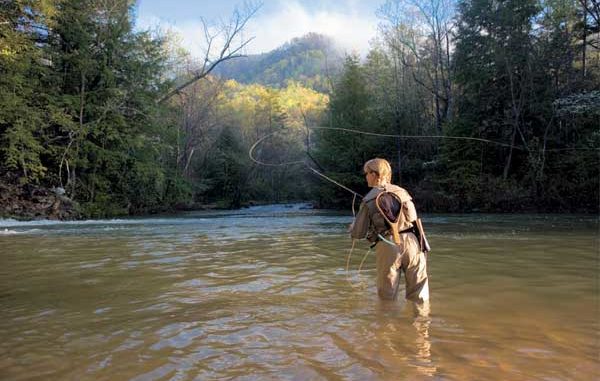
The month of March is often accompanied by high water in the area’s trout streams and rivers.
Although heavy, late-winter and early-spring rains can create conditions that first appear unfishable, high water is often when a stream’s biggest fish can be caught. Having enough confidence and knowing how to approach this type of water might be the ticket to landing the biggest trout of your lifetime.
If the current is high and the water discolored, fish are just as unhappy with the conditions as most anglers are trying to fish it. Trout will congregate closer to the bank, in shallow water where they don’t have to fight the strong current. Back eddies and pockets of slack water will be the most likely places to find fish. Riffles that are normally too shallow to hold fish during normal conditions can provide a feeding lane during high water.
The turbid water of early spring can create a big advantage for the angler. Fish are not easily spooked under these conditions and will almost always feed with less caution. This is particularly true for larger fish.
Spring run-off also sends a trout’s metabolism soaring. The season’s warmer water temperatures spark a biological urge in these cold-blooded creatures to feed with more gusto. Rain will wash more food into the water, and the stronger currents dislodge aquatic insects from their strongholds along the bottom.
During high water, rising fish will be very rare. Trout can still be coaxed into hitting a dry fly, but the fly should be a sturdy floater and big enough for fish to see through the murky water. Big attractor flies such as the Royal Wulff, Stimulator, or Humpy are good choices.
If you want much better odds in these conditions, however, target fish below the surface. Ninety percent of a trout’s feeding activity is done below the water’s surface during normal flows, but the percentage is pushed even higher during heavier currents.
High, murky water typically calls for nymphs, wet flies and streamers. Real nymphs will have difficulty swimming under these conditions, so most insects that trout will encounter will be drifting helplessly through the current. A dead-drifted nymph is the only way to fish the fly during this time. I always fish a nymph in a larger size than normal, since fish will have more difficulty seeing the fly.
As for nymph patterns, start with the basics. The Pheasant Tail, Hare’s Ear, and big stonefly nymphs will catch fish in any water conditions. Use plenty of weight or split shot to get the fly down to the stream bottom. Vary the amount of weight used and experiment. If you are not getting hung up every now and then, you are probably not getting deep enough.
Streamers also work very well during high, early spring water. Dead-drift these deadly flies as close to the bottom as possible and be prepared for hard strikes. When you find a fly and water depth that works, stick with it. Fish will bunch up in favorable lies that shield them form the heavy current, so several fish may be caught from the same spot.
As earlier noted, trout are much less cautious, so shorter, heavier leaders and tippets can be used. If 5X is the norm during average flows, 4X or even 3X will now work. This could make the difference when that big, bottom-hugging brown trout hits your fly and zooms toward those submerged tree roots along the bank.
Wading is not always required if fish are holding close to the river’s edges. If you do need to wade, extreme caution obviously should be taken. With little or no visibility below the surface, your footing becomes much more uncertain, and strong currents can sweep you off your feet without warning. A wading staff is essential when trying to cross a river during high water.
March can be a difficult month for catching trout because of high water and cold temperatures. For that reason, the conditions will probably allow you do enjoy the water in relative solitude. If you are patient and you follow some of the advice offered here, your reward might just be that fish of your dreams.



Be the first to comment